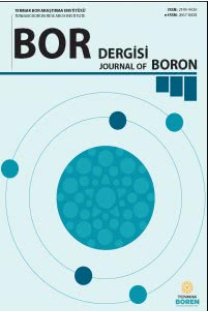Synthesis and characterization of trimethoxy boroxine
Synthesis and characterization of trimethoxy boroxine
___
- [1] Coulson C. A., Dingle T. W., The B–O bond lengths in boron–oxygen compounds, Acta Crystallogr. Sect. B Struct. Crystallogr. Cryst. Chem., 24, 153–155, 1968.
- [2] Welch M. B., United States patent, Geothermics, 14, 595–599, 1985.
- [3] Delpierre S., Willocq B., De Winter J., Dubois P., Gerbaux P., Raquez J. M., dynamic ıminoboronate-based boroxine chemistry for the design of ambient humidity-sensitive self-healing polymers, Chem. A Eur. J. 23, 6730–6735, 2017.
- [4] Kalemos A., The nature of the chemical bond in borazine (B3N3H6), boroxine (B3O3H3), carborazine (B2N2C2H6), and related species, Int. J. Quantum Chem., 118, e25650 2018.
- [5] Fisher H. D., Lehmann W. J., Shapiro I., Trifluoroboroxine: Preparatıon, infrared spectrum and structure 1., J. Phys. Chem., 65, 1166–1168, 1961.
- [6] Farber M., Heat of formation and entropy of the trimer of boron oxyfluoride, J. Chem. Phys. 36, 661–664, 1962.
- [7] Latimer B., Devlin J. P., Vibrational spectra of fluorine and chlorine derivatives of boroxine—II, Spectrochim, Acta Part A Mol. Spectrosc., 23, 81–88, 1967.
- [8] Seyferth D., Gmelin Handbuch der Anorganischen Chemie, Erganzungsband zur 8. Auflage, Vol. 13, Borverbindungen, Teil 1, Binare B-N Verbindungen, B-N-C Heterocyclen, Polymere B-N Verbindungen, J. Organomet. Chem., 1974.
- [9] Köster R., Organoboron Chemistry. VonH. Steinberg. Band 1: Boron-Oxygen and Boron-Sulfur Compounds. Interscience Publishers, A Division of John Wiley & Sons, Inc., New York-London-Sidney 1964. 1. Aufl., XXXII, 950 S., zahlr. Tab., geb. £ 12.8.0. Angew. Chemie 77, 108–108, 1965.
- [10] Wilcox N. J., Kwochka W. R., Phenyl Replacement Reactions : Solvent Effects on Reactions of Boroxines with Primary Amines, 2015.
- [11] Lappert M. F., 568. Cyclic organic boron compounds. Part I. Preparation, characterisation, and stability of esters of metaboric acid, J. Chem. Soc., 2790 1958.
- [12] Boroxine Derivatives as flame retardant, WO 2006/089937 A1, 2006.
- [13] Commerford J. D. Chamberlain D. L., Shepherd J. W., Trimethoxy boroxine—An Extinguishing Agent for Metal Fires, Adv. Chem., 23,158–162, 1959.
- ISSN: 2149-9020
- Yayın Aralığı: 4
- Başlangıç: 2016
- Yayıncı: TENMAK Bor Araştırma Enstitüsü
Synthesis and characterization of trimethoxy boroxine
Triangular potential effects on the fermi velocity renormalization in 8-Pmmn borophene
Bor nitrür nanoplateletlerin ve nano Ag takviyeli yapısal yapıştırıcıların kayma dayanımı
Hekzagonal bor nitrür takviyeli akımsız nikel kaplamanın özelliklerine ısıl işlemin etkisi
Mustafa KOCABAŞ, Halil YILMAZ, Nurhan CANSEVER
